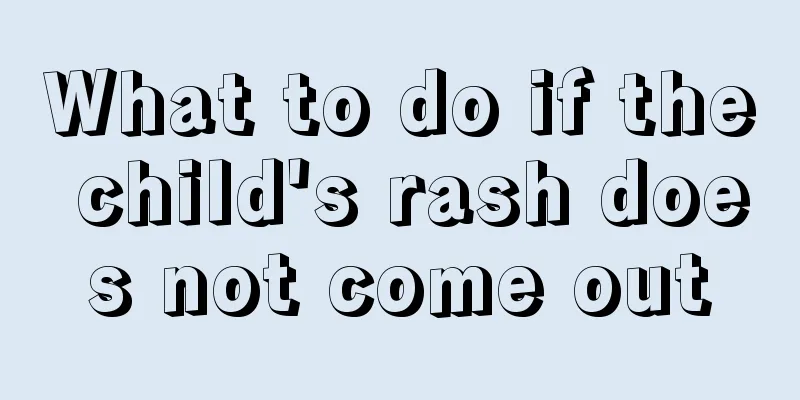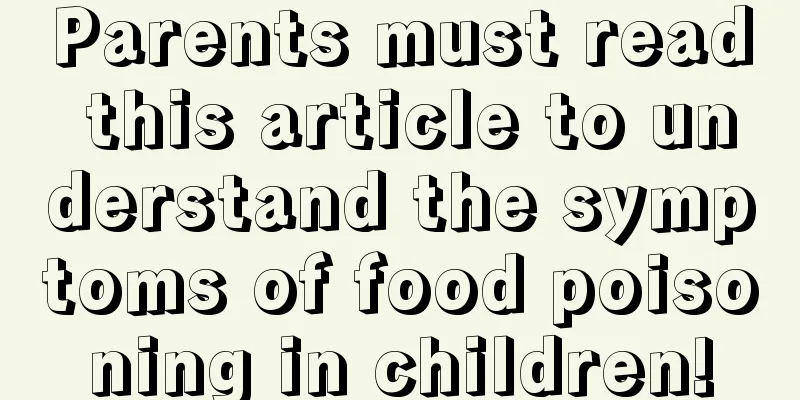What to do if the child's rash does not come out

|
It is a very common symptom for children to have rashes on their bodies during their growth and development. Generally, rashes will easily appear on the baby's skin after a fever. It is also a very common symptom for children not to have rashes on their bodies. This may be due to physical reasons. Parents can observe the child in time. If there are any abnormalities, detailed examinations and treatment are needed. What should I do if my child's rash doesn't come out? If a child has a fever and the rash does not appear, timely and targeted treatment is needed. Generally, there is no need to worry if there are no symptoms. How to tell if it's a rash The first sudden onset of fever in a child since birth. If your baby is between 6 and 18 months old and has not been left out to dry, and suddenly develops a high fever, the first thing to suspect is a rash. The high fever reaches over 38°C, and there are no other obvious cold symptoms. It's just a fever, with the temperature remaining between 38℃ and 40℃. Some young children may have a mild cough or runny nose, but there are no other obvious cold symptoms. Routine blood tests showed no significant abnormalities. Some parents may be worried and go to the hospital for a blood test, but the test results may not show anything abnormal. Some people may have a white blood cell count slightly above or below the normal range, which is normal. How to deal with rashes Measure body temperature every half hour and perform physical cooling when fever is high. If your child suddenly develops a fever, there is no need to panic. First measure the body temperature. If it exceeds 38.5℃, you can first use physical cooling methods to deal with it. Put a cooling patch on the child's forehead and use alcohol to wipe the child's palms, soles of feet, neck, armpits and other hot areas. This may be the most difficult time for parents. Measure the child's temperature every half an hour. If the temperature remains above 39°C and the child starts crying, getting irritable or even having convulsions, you can try using children's antipyretic drugs such as Motrin and Tylenol, and use sedatives if necessary. Don't worry too much, comforting yourself is the key. Some parents take their children to the hospital as soon as they see they have a fever. The doctor will eventually determine that it is a fever or pharyngitis and will prescribe some antipyretics. In fact, the doctor dare not conclude that it is a rash and dare not let the parents and children bear it. The medicine prescribed for you is actually a psychological placebo. More than 80% of young children will experience the process of having a rash. When a rash appears, general medicines are ineffective against it. Giving children medicine can only serve as psychological comfort. So at this time, parents must comfort themselves and their families while comforting their children. |
<<: What to do if your child crosses his eyes
>>: Newborn rash with white tips
Recommend
What to do if baby's buttocks are broken
The skin of a newborn is relatively delicate, so ...
How to judge whether the baby has bloating
Flatulence is a disease that occurs near our stom...
How to eat probiotics for six-month-old babies
Probiotics can relieve the baby's intestines,...
What are the symptoms of excessive lead in babies? Pediatric experts answer
Many people may have heard of lead poisoning. If ...
Do mothers know the height standard for two-year-old babies?
Every mother has been looking forward to her chil...
Can childhood asthma be eradicated?
Asthma is a disease that occurs frequently and ha...
Baby's back is sweaty and cold
If you find that your baby's back is sweating...
What are the dangers of insufficient sleep for babies?
In today's society, the competitive pressure ...
What should I do if my two-month-old baby has a blocked nose?
Most of the time, stuffy noses are caused by cold...
What can children eat to get better quickly from coughing?
I believe that everyone has experienced the tortu...
What are the symptoms before your baby starts teething?
We all know that babies have no teeth after they ...
What is the reason for low urine output in children?
Why do children have less urine output? Many pare...
What to do if your child has periodic stuttering
Stuttering is what we usually call stammering. It...
What causes a child's heart to ache?
The physical health of children is a very importa...
How to treat sudden vomiting in baby
The birth of every new life makes our parents ver...









